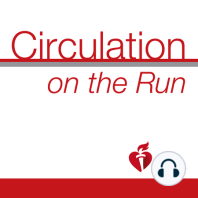18 min listen
Circulation July 21, 2020 Issue
ratings:
Length:
26 minutes
Released:
Jul 20, 2020
Format:
Podcast episode
Description
This week’s episode of Circulation on the Run features author Robert Yeh and Associate Editor Brendan Everett as they discuss the article "Use of Administrative Claims to Assess Outcomes and Treatment Effect in Randomized Clinical Trials for Transcatheter Aortic Valve Replacement: Findings from the EXTEND Study." TRANSCRIPT Carolyn Lam: Welcome to Circulation on the Run, your weekly podcast summary and backstage pass to the journal and its editors. I'm Dr Carolyn Lam, Associate Editor from the National Heart Center and Duke National University of Singapore. Greg Hundley: And I'm Greg Hundley, Associate Editor, Director of the Pauley Heart Center at VCU Health in Richmond, Virginia. Well, Carolyn this week, we're going to examine outcomes in patients that have undergone transcatheter aortic valve replacement or TAVR. I can't wait to get to the results from the EXTEND study. But before we do that, how about we grab a cup of coffee and start in with some of the papers and maybe I'll go first this time. My paper involves a validated model for sudden cardiac death risk prediction in pediatric hypertrophic cardiomyopathy. And the corresponding author is Dr Seema Mital from the Hospital for Sick Children. Well, Carolyn in this study, the objective was to develop and validate a sudden cardiac death risk prediction model in pediatric hypertrophic cardiomyopathy to guide sudden cardiac death prevention strategies. To address this, the authors performed an international multi-center observational cohort analysis. Phenotype positive patients with isolated hypertrophic cardiomyopathy, who were under the age of 18 years at diagnosis were eligible. The primary outcome variable was the time from diagnosis to a composite of sudden cardiac death events at five years of follow-up. That included sudden cardiac death, resuscitated sudden cardiac arrest, and aborted sudden cardiac death, that is, an appropriate shock following primary prevention ICD. Carolyn Lam: Nice. What did they find? Greg Hundley: Well, overall 572 patients met the eligibility criteria with 2,855 patient years of follow-up. The five-year cumulative proportion of sudden cardiac death events was 9%. Risk predictors included age at diagnosis, documented non-sustained ventricular tachycardia, unexplained syncope, septal diameter Z scores, LV posterior wall diameter Z scores, LA diameter Z scores, peak LV outflow tract gradients, and the presence of a pathogenic variant. Now, unlike adults, LV outflow tract gradient had an inverse association and family history of sudden cardiac death had no association with sudden cardiac death. The combination of clinical and genetic data were developed to predict five-year freedom from sudden cardiac death. In conclusion, the authors study provides a validated sudden cardiac death risk prediction model with over 70% prediction accuracy and incorporates risk factors that are unique to pediatric hypertrophic cardiomyopathy. These results therefore raise the possibility that an individualized risk prediction model has the potential to improve the application of clinical practice guidelines and shared decision making for these children prior to an ICD insertion. Carolyn Lam: Very interesting. Well, Greg, have you ever wondered what are the temporal trends in the burden of comorbidities and risk of mortality among patients with heart failure with preserved ejection fraction or HFpEF and heart failure with reduced ejection fraction or HFrEF? Well, the next paper comes from Dr Caughey and colleagues from University of North Carolina and North Carolina State University who performed an analysis of the community surveillance component of the atherosclerosis risk in communities, or ARIC study, and they found a significant increase in the burden of comorbidities among hospitalized patients with HFpEF as well as HFrEF across both sexes. Higher number of comorbidities was associated with higher risk of one-year mortality with a stronger association noted a
Released:
Jul 20, 2020
Format:
Podcast episode
Titles in the series (100)
Circulation November 28, 2017 Issue: Circulation Weekly: Your Weekly Summary & Backstage Pass To The Journal by Circulation on the Run
